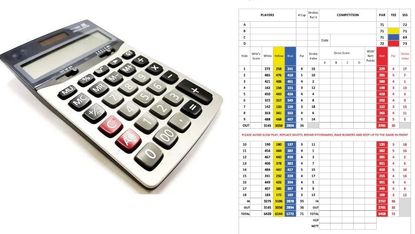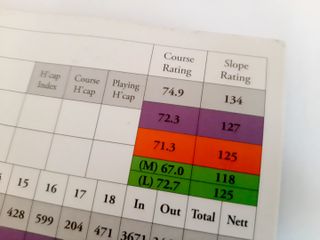What Is The Highest Golf Handicap?
What is the highest golf handicap you can play off? Thought it was 54? Think again, as your Course Handicap could be even higher...


The highest official golf handicap that a player can have changed with the introduction of the World Handicap System (WHS), which went live in early 2020 and was adopted in the UK&I in November that year.
Under the WHS, golfers are given a Handicap Index rather than a handicap and this is “a measurement of a player's potential ability on a course of standard playing difficulty". This Handicap Index – which is nothing to do with stroke index incidentally – is then used to calculate the number of shots that a golfer gets at a specified course according to that particular course’s playing difficulty.
This number of shots is the Course Handicap that a golfer gets for that round according to which set of tees they are playing from that day. Most clubs will have a WHS Course Handicap chart showing you how many shots you get from each set of tees on the club website and then either on the noticeboard or somewhere near the 1st tee.

Most golf clubs will have a WHS Course Handicap chart displayed fairly prominently somewhere
The maximum Handicap Index is 54 for both men and women. But the handicap a player receives on the day varies from course to course and does not have to equal the Handicap Index - indeed, it rarely does. Instead a calculation based on the Handicap Index and the difficulty of the course gives a player their Course Handicap for that round.
The two measurements of the course’s difficulty which are relevant to this calculation are its Course Rating and Slope Rating. Course Rating is simply the score it is reckoned that a scratch golfer should make round the course. As such, it is normally pretty close to the par of the course, but need not be.

Slope Rating and Course Rating both play a role in determining your Course Handicap for a given round
The difficulty of the course is expressed by its Slope Rating, with each set of tees at a course having its own rating. Slope Ratings range from 55 to 155, with the higher the rating the harder the course. A Slope Rating of 113 is considered to be the norm and it is this figure that is then used as a divisor in the Course Handicap calculation.
Examples of golf courses that have a 155 slope rating are the Albatros Course at Le Golf National, which hosted the Ryder Cup in 2018 and the Ocean Course at Kiawah Island, which hosted the 1991 Ryder Cup.
Get the Golf Monthly Newsletter
Subscribe to the Golf Monthly newsletter to stay up to date with all the latest tour news, equipment news, reviews, head-to-heads and buyer’s guides from our team of experienced experts.

According to its Slope Rating, the Ocean course at Kiawah Island is one of the most difficult on the planet
How many shots a player gets at a course, that is to say a player’s Course Handicap, is then determined by this formula:
Handicap Index x Slope Rating/113 + (Course Rating - Par)
To provide the most extreme example, if a player with a 54 Handicap Index were to play the Ocean Course at Kiawah Island from the Championship tees, then their Course Handicap would be:
54 x 155/113 + (79.1 - 72) = 81.2
In other words, 27 shots more than their Handicap Index!
That said, it would be more than a little unwise for a 54-index golfer to be tackling such a difficult golf course from the very back tees.
Contributing Writer Golf courses and travel are Roderick’s particular interests and he was contributing editor for the first few years of the Golf Monthly Travel Supplement. He writes travel articles and general features for the magazine, travel supplement and website. He also compiles the magazine's crossword. He is a member of Trevose Golf & Country Club and has played golf in around two dozen countries. Cricket is his other main sporting love. He is the author of five books, four of which are still in print: The Novel Life of PG Wodehouse; The Don: Beyond Boundaries; Wally Hammond: Gentleman & Player and England’s Greatest Post-War All Rounder.
-
 Verne Lundquist Lifts Lid On Emotional Masters Farewell With Tiger Woods
Verne Lundquist Lifts Lid On Emotional Masters Farewell With Tiger WoodsTiger Woods shared a poignant moment with the legendary broadcaster beside the 16th green in the final round at Augusta
By Ben Fleming Published
-
 John Catlin Wins Back-To-Back Asian Tour Titles Whilst LIV Golfer Likely To Remain Outside World's Top 100 Despite Strong Showing
John Catlin Wins Back-To-Back Asian Tour Titles Whilst LIV Golfer Likely To Remain Outside World's Top 100 Despite Strong ShowingThe American cruised to the Saudi Open title by seven shots, while David Puig is likely to stay outside the world's top 100 despite finishing fifth
By Matt Cradock Published